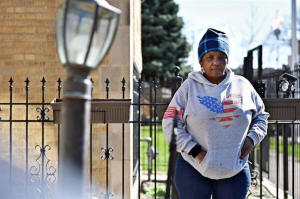Flooding is Illinois’ Most Threatening Natural Disaster. Are We
Prepared?
 Send a link to a friend
Send a link to a friend
 [April 26, 2024]
by Meredith Newman, Illinois Answers Project [April 26, 2024]
by Meredith Newman, Illinois Answers Project
April 16, 2024
This story was originally published by the Illinois
Answers Project.
The electricity in Mary Buchanan’s home in West Garfield Park was not
working – again.
The outage lasted four days, starting just after a crew dug up her front
lawn to install a check valve in late March, in order to stop waste
water from pouring into her basement. She told herself this $12,000
construction would be worth it if it means no more flooding.
Last summer, as historic rain pelted down on Cook County, Buchanan was
left standing in the basement of her childhood home with dirty water
wading up to her knees. Every day since has presented a new problem:
discovering black mold scattered throughout the basement, having to
replace the water heater and then getting denied for federal emergency
funds.
The July 2023 storm – one of the costliest weather events in Chicago’s
history – hit hardest in the city's West Side and nearby suburbs. The
storm upended Chicagoans’ lives and exposed the city's longstanding
vulnerabilities to flooding. In the wake of the storm, FEMA inspected
63,000 homes, and distributed up to $375 million in federal aid to home
and business owners.
It also provided a look into a concerning future: The grip of climate
change unyielding, winter and spring are expected to be wetter in
Illinois while summer becomes even hotter. The downpour of rain will
likely continue to be more intense for shorter durations and the
locations where these flash flooding storms hit are less predictable,
said Illinois State Climatologist Trent Ford.
The Illinois Answers Project interviewed a range of experts on flooding,
climate and infrastructure to examine how prepared Chicago and the state
are to combat the growing environmental threats its residents face,
particularly from the problem of severe flooding. In this series over
the next several weeks, Illinois Answers will explore how Chicago is
trying to improve drainage in neighborhoods, how a promising flood
prevention project got mired in bureaucracy, and how a state buyout
program is helping residents when they have nowhere else to turn.

Flooding is the state’s most threatening natural disaster and touches
every corner in Illinois, but communities of color and poorer areas
often face the greatest risk – particularly in the city of Chicago and
greater Cook County. Sewer and stormwater infrastructure can often no
longer handle the onslaught of water that comes from these heavy
rainfalls, experts told Illinois Answers. Chicago also has one of the
largest numbers of properties at risk for flooding in the coming
decades, research shows.
While a state task force has developed a long-range plan for flood
mitigation across Illinois, Chicago has no equivalent roadmap.
Part of the city's challenge is that multiple agencies share
responsibility for flood mitigation in Chicago and Cook County. In an
attempt to coordinate efforts, the Metropolitan Water Reclamation
District of Greater Chicago has developed plans for new anti-flooding
infrastructure for the South and West Sides, but the agency has refused
to release them to Illinois Answers, saying the designs are not ready
for implementation – despite their completion two years ago.
Angela Tovar, who leads the newly reconstituted Chicago Department of
the Environment, declined interview requests with Illinois Answers but
in an emailed statement said her office will “collaborate and advise”
other city agencies on flood-related policies as it continues to staff
up, and that her team is working with the mayor’s office on “outlining a
strategic direction for water policy issues in the city.”
She is “committed to climate justice and climate resiliency in Chicago,”
she wrote. “We know that climate change will only exacerbate
long-standing flooding challenges in many of our neighborhoods. Too
often those Chicagoans impacted by flooding are also overburdened by
other environmental harms.”
It’s been almost a year since the devastating flood hit the West Side,
and Buchanan is among the many residents still struggling to repair
homes that have been in families for generations. In the five decades
that her family has lived there, she could only recall the basement
flooding once, with minimal water that receded in an hour or so.
“My mother would die if she saw it like this,” Buchanan said.
The basement apartment, where Buchanan’s adult daughter lived, has been
gutted down to its studs. She has had to replace the water heater and
furnace and also fill out the painstaking FEMA applications, which took
Buchanan hours to complete. Not to mention the subsequent denials and
appeals.
Almost nothing in her basement was salvageable after the storm: The red
plush carpet has been torn up. The bathroom and kitchen are no more. The
antique wood furniture that belonged to her mother had to be trashed.
The black mold that festered in her basement’s walls for months was
finally removed in December. But Buchanan can’t seem to shake a cough.
It gets so bad, she said, she finds herself nearly choking. At 68 years
old, she is having asthma attacks for the first time in her life.
Buchanan said her fixed income means she’s struggling to afford the
costs to repair her home and prevent future flooding.
“I want this house to stay in my family,” she said. “My mom worked too
hard.”
Why Illinois is So Vulnerable to Flooding
Storms like those from last summer are no longer once in a decade.
Scott Lincoln, senior service hydrologist for the National Weather
Service forecast office in Chicago, said he could not recall the last
time Cook County had two federally declared flood disasters during the
same year, referencing storms on July 2 and Sept. 17 of last year.

This decade, though still in its infancy, has seen three extreme
rainfall events –– the highest known number since 1950, Lincoln said.
“It's not an if, it's more of a when,” Lincoln said of the next extreme
rain event.
The state’s climate has gotten wetter in the springtime, which combined
with rapid snowmelt and heavier rainfall means rivers in Illinois are
often breaking records for highest peaks, said Ford, the climatologist
who provides weather and climate data to Illinois farmers, policymakers
and government agencies.
Non-river flooding, or pluvial flooding, “is equally or maybe even more
so a problem” for Illinois, Ford said. That’s because heavy
precipitation, lasting anywhere from an hour to a couple of days, can
“just overwhelm the landscape.”
This type of flooding is also less predictable, Ford said. For example,
scientists and state officials would be able to determine days in
advance if the Mississippi River is going to flood the city of Quincy,
allowing time for preparation, he said.
But with non-river flooding, it’s much more difficult, Ford said. These
heavy rainfall events often occur outside of the areas where floodplains
are diligently mapped.
How a city or town’s infrastructure will respond to flooding from a
series of storms is complicated to predict, he said.
Wetlands and prairies, which once made up much of Illinois, work as a
sponge to soak up rainwater – which ultimately reduced the risk of
stormwater runoff and widespread flooding. But now many of these areas
have turned into farms and cities and towns, filled with roads, parking
lots and homes.
As a result, these impervious areas prevent water from easily
infiltrating into the ground, said Glenn Heistand, section head of the
Illinois State Water Survey’s Coordinated Hazard Assessment and Mapping
Program. Instead, it creates even more runoff that overwhelms
stormwaters systems.

[to top of second column]
|

Mary Buchanan, 68, stands outside her home in West Garfield Park on
March 21, 2024, examining the recent construction to her front lawn.
She paid $12,000 to install a check valve to prevent waste water
from flowing into her home the next time her neighborhood floods.
Her basement was significantly damaged in July 2023 after a major
storm. (Credit: Victor Hilitski, for the Illinois Answers Project)

Scientists with the Water Survey, housed at the University of Illinois,
conduct research on various water issues. Heistand and his team work to
identify areas in Illinois that are at high-risk for flooding as well as
assess flood hazards. The team also works with towns and cities to help
local governments understand the flooding risks they face.
Stormwater systems, Heistand said, were designed and built to handle a
certain amount of water. The frequency and intensity of rain storms have
upended the system's ability to be effective. Towns and cities also have
a varying ability to maintain their aging infrastructure.
In Chicago, with more than 4,500 miles of sewer lines to oversee, the
Department of Water Management faces constant dilemmas over which mains
the city should upgrade or replace with its limited resources, said
Brendan Schreiber, who oversees sewer management for the department.
Schreiber likened the city’s labyrinthine sewer system to its network of
streets and highways, saying a storm event is like rush hour: “Water
goes into the system and it’s all trying to get to the same point at the
same time, and that causes it to back up. … What we focus on is reducing
that risk.”
The department aims to maintain every city sewer to the point where it
can handle a “five-year storm,” as defined by the Water Survey’s 2020
report Schreiber said. For comparison, parts of the West Side
experienced a 50-year storm when they received more than 7 inches of
rain in a single day, according to rain data from PRISM Climate Group, a
national weather database operated out of Oregon State University.
The Department of Water Management does not maintain maps showing the
age or capacity of its sewers, said spokesperson Megan Vidis. Instead,
officials mostly rely on 311 flood complaints to decide which sewers to
replace, Schreiber said.
What Chicago and the State Are Doing to Combat Flooding
Chicago is second in the country for the greatest number of properties
at risk of flooding, according to First Street Foundation, a nonprofit
that researches climate risk.
It’s expected to get even worse: Cook County has about 172,000
properties at substantial risk for flooding, according to data First
Street provided to Illinois Answers. This group projects it to grow by
about 10% by 2053.
These figures are larger than that of FEMA since the nonprofit factors
in pluvial flood risk, which the federal agency does not.
In 2022, the state updated its water plan for the first time in 35
years, said Terra McParland, flood surveillance program manager for the
state Office of Water Resources.
The statewide report focused on the most pressing water concerns and the
task force made 15 flood damage mitigation recommendations. Among them:
update the state’s rainfall prediction data, which is used to design
infrastructure; identify underserved communities that need help with
flood planning; and create a pilot urban flood warning system.
McParland, who oversaw the flood damage mitigation section, said this
was the first year the plan explicitly discussed the impact of climate
change and focused on social and environmental justice. She said the
state water plan is expected to be updated every 10 years.
Chicago’s approach to the issue is more complicated.
Multiple city departments have pursued initiatives related to flood
control. The city’s Department of Water Management, for example, plans
this year to build a pair of underground storage tanks on the West Side
capable of holding a combined 1.6 million gallons of stormwater, Vidis
said. A longer-running project would add a 10-mile tunnel by the end of
the decade to alleviate basement flooding for about 30,000 residents on
the South and Far South sides, she said.

But the city is worse off for the lack of a unified, cross-departmental
plan to seek funding and prioritize spending on the issue, said Ald.
Maria Hadden (49), chair of the City Council Committee on Environmental
Protection and Energy.
Last fall, Hadden introduced a resolution calling for a non-binding
question to be added to the March 2024 primary ballot asking if Chicago
should develop a “comprehensive flood mitigation plan.”
Hadden’s resolution for a ballot referendum did not pass, but the
alderwoman said she hopes to use her committee to help corral city
departments into a unified plan on flood control and prevention. The
responsibility also lies with Mayor Brandon Johnson and the Department
of the Environment, she said.
“The question is … can we all get on the same page and identify this as
a priority?” she said.
‘I Feel Left Behind’
During the July storm, a majority of 311 calls about basement flooding
were concentrated in predominantly Black neighborhoods on the West Side,
city data shows.
The city registered water-in-basement complaints from nearly 7,000
addresses in the first week of July 2023. More than half were from five
community areas: Austin, West Garfield Park, Belmont Cragin, Humboldt
Park and North Lawndale.
Queen Jackson, 83, said she called 311 during the July storm to report
the flooding of her West Garfield Park home. Jackson has been
disappointed in the lack of aid from the city.
Instead, she has turned to Princess Shaw, a longtime Lawndale organizer
who formed the West Side Long-Term Recovery Group to help residents
struggling to clean up their homes and navigate federal bureaucracy.
Shaw has also met with city officials, advocating for more aggressive
infrastructure improvements. She believes the city has provided only
“Band-Aid” fixes, like rain barrels and relining pipes, and instead
wants longer term solutions.
Shaw estimates the group is working with 250 families, helping them get
mold removed from their flood-damaged homes and fill out paperwork to
submit to FEMA to receive federal aid.
In Jackson’s home, where she raised children and grandchildren over six
decades, splatters of orange and brown mold are on the walls throughout
her basement. Wood is warped from the water damage and pieces of broken
tile are still scattered throughout. A damp smell lingers. Her grandson
still lives in the basement.
A contractor estimated $46,000 was needed to repair Jackson’s basement
and roof. She said she only received a fraction of that from FEMA.
“We work all our lives,” Jackson said of her disappointment at the
government’s response. “I never had to file for nothing. I asked for
nothing free. I paid for everything. And … now that I’m retired, I don’t
get that check every week like I used to...”
“I feel left behind – period.”

Buchanan isn’t sure when the basement in her West Garfield Park home
will become livable again for her daughter. She has been approved for
about $32,000 in federal aid, just half of what she said is the
estimated damage to her basement. But it required her appealing to FEMA
multiple times.
When it rained in March, Buchanan rushed down to check her basement – no
water.
“I'm just praying,” she said, “no more problems.”
Contributing: Alex Nitkin
This story was made possible by a grant from The Richard H. Driehaus
Foundation to the Illinois Answers Project. |